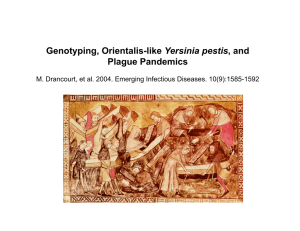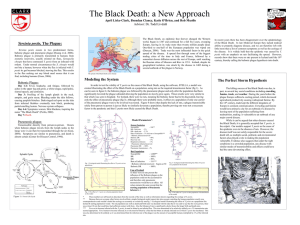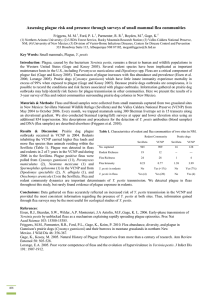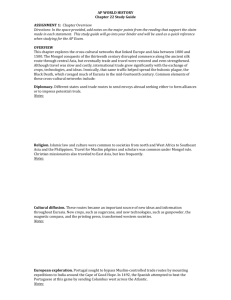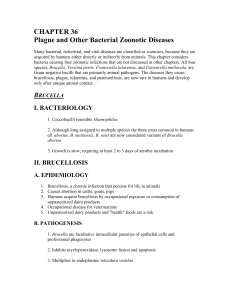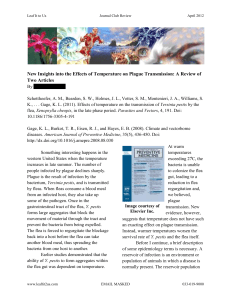14b
advertisement
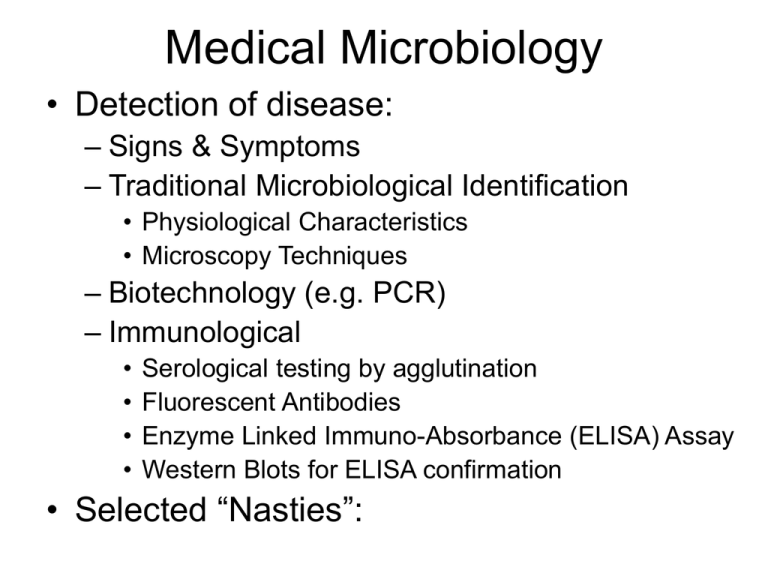
Medical Microbiology • Detection of disease: – Signs & Symptoms – Traditional Microbiological Identification • Physiological Characteristics • Microscopy Techniques – Biotechnology (e.g. PCR) – Immunological • • • • Serological testing by agglutination Fluorescent Antibodies Enzyme Linked Immuno-Absorbance (ELISA) Assay Western Blots for ELISA confirmation • Selected “Nasties”: Agglutination Serological Test Figure 18.6 Fluorescence Microscopy direct ELISA indirect Yersinia pestis Black Death Taxonomy • Member of the Enterobacteriaceae family Yersinia is a Gram-negative coccobacilli Target Tissues • This disease direct effects the lymph nodes which can be found in the groin, neck, and armpits and cause them to enlarge and suppurate. Ecology and Infection Process Flea draws viable Y. pestis organisms into its intestinal tract, and they multiply. • Biological vectors Fleas Rodents Some Y. pestis in the flea regurgitated when the flea gets its next blood meal thus transferring the infection to a new host. A few bacilli are taken up by tissue macrophages after they lose their capsular layer. Macrophages can’t kill Y. pestis and provide protected environment for bacilli so they can re-synthesize their capsular layer. The re-encapsulated organisms then kill the macrophage and are released into the extracellular environment where they travel to draining lymph nodes. Symptoms Bubonic Plague bacteria infect lymph nodes • Bubos Fever Headache Vomiting Blood Diagnostic Tests • Take smear from blood or feces for bubonic plague > bacteria has “safety pin” appearance Can also use FA (fluorescent-antibody) test All plague bacilli have unique diagnostic envelope glycoprotein called the Fraction 1 (F1) antigen Treatments and Preventive Measures 7- to 10-day course of antimicrobic therapy • streptomycin • chloramphenicol • tetracycline Vaccine: Y. pestis organisms grown in artificial media, inactivated with formaldehyde, and preserved in 0.5% phenol. The vaccine contains trace amounts of beef-heart extract, yeast extract, agar, and peptones and peptides of soya and casein. Control of rat populations concurrent with elimination of their flea prevent spread of the plague to humans. Epidemiology: Transmission Bubonic Infected Rodent Fleas Humans Can also enter through breaks in skin when handling infected animal Prevalence and Distribution in Global Human and Animal Populations 1000- 3000 cases reported annually across the world •Africa (most cases) •Asia •Northeastern Brazil •Andes Mountain Regions •US (19-40 cases a year mostly in Western areas such as New Mexico and Arizona) Mortality Bubonic Plague Untreated 50- 60% mortality rate Treated 5 – 20% mortality rate Killed one third of the world’s population during the 14th century Latest reports As of 15 March 2001, World Health Organization has reported a total of 436 suspected cases, including 11 deaths in Nyanje area in Zambia. As of 27 May 2002, the Malawian Ministry of Health has reported a total of 71 cases of bubonic plague in Malawi. Latest research EVOLUTION: A single gene change in a relatively benign recent ancestor of the bacterium that causes bubonic plague played a key role in the evolution of the deadly disease from a germ that causes a mild human stomach illness acquired via contaminated food or water to the flea-borne agent of the "Black Death.” GENETICS: Research on three genes, hemin storage (hms) genes, in Y. pestis that change it from a harmless, long-term inhabitant in the flea midgut to one that amasses in its foregut. PREVENTION: Current prevention measures include dusting family pets with insecticides to prevent the spread of the Yersinia pestis organism from the native prairie dog populations
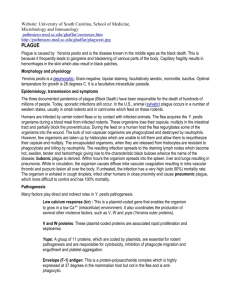


![[Presentation by Sara Morgans].](http://s2.studylib.net/store/data/005578977_1-95120715b429730785aca2fdba9a2208-300x300.png)
